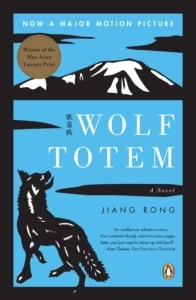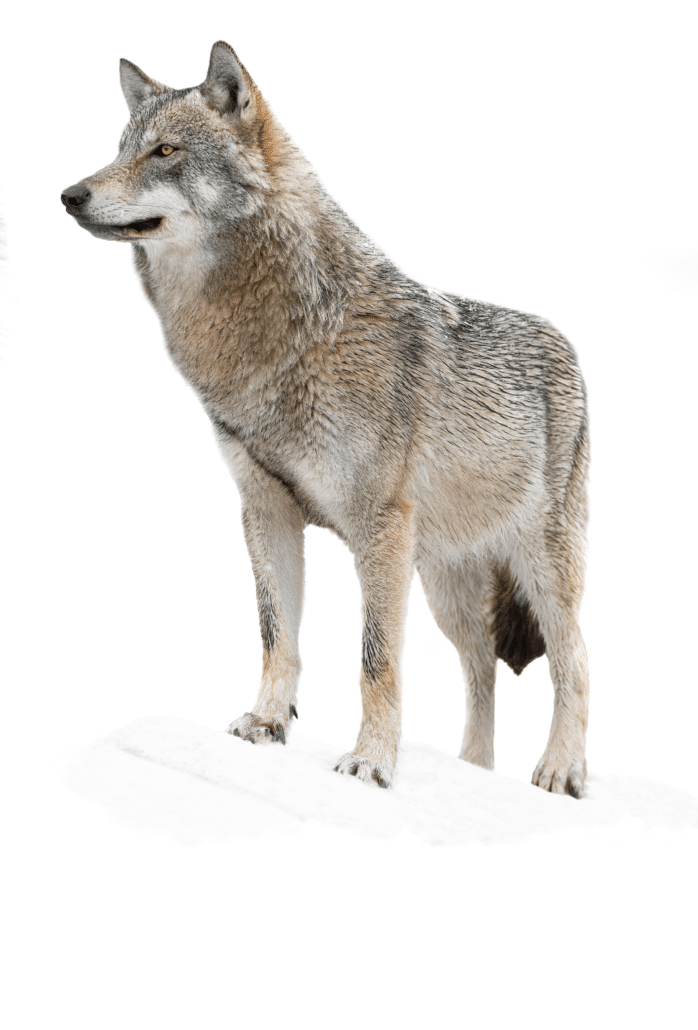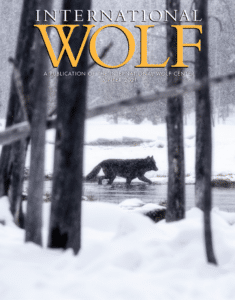 By Debra Mitts-Smith
By Debra Mitts-Smith
In 1949, the People’s Republic of China ushered in collectivized farming and livestock production. The government, which envisioned the people’s utopia as one where humans had conquered nature, regarded attacks on crops and livestock by wildlife such as sparrows, wolves, tigers, and other predators as attacks on the nation. To attain the utopian ideal, wolves and other species deemed as “harmful” were aggressively hunted and killed by government campaigns. For example, in 1952, government officials in Ningxia Hui Autonomous Region organized 1,000 people into wolf hunting teams. Equipped with firearms, poison and traps, these teams killed more than 900 wolves. The hunting teams, lauded as “wolf-fighting heroes,” received highly prized rewards for killing wolves.
By the 1980s, government eradication campaigns, excessive hunting and the lack of a scientific approach to the management of natural resources resulted in extirpation or near extirpation of many species. After three decades of seeking to eradicate species, the government shifted its policy on nature and the environment. In 1988, China issued its list of “first-class protected species.” This list, known as the Three Haves, safeguarded wildlife perceived to have economic value, scientific significance or other beneficial characteristics. Among the animals on the 1989 list were the remaining five or six South China tigers and leopards—yet the wolf and other predators such as bears and the doglike dholes continued to be targeted as harmful species.
In February 2021, China issued an updated protected species list, adding almost 500 species, many of which had been previously deemed harmful—including the wolf. This change in status signaled a switch from the decades-long government policy of directing and rewarding the extirpation of wolves and other large predators to today’s policy, under which the killing of a wolf or other species on the protected list results in fines and even imprisonment.
Several factors are seen as contributing to this change in the wolf’s status. Environmentalists and scientists in China have worked to undo the misconceptions about the wolf—misconceptions that are rooted in fear, folk beliefs, traditional proverbs and folktales. These traditional images depict the wolf as a monstrous and cruel beast that stalks in the night and attacks people in their homes. As in many traditional European and Euro-American tales, proverbs and fables, many Chinese traditional narratives and sayings use the wolf to represent dangerous humans or situations. These usages in turn help to perpetuate misunderstandings about the wolf.
In the proverb called, “Ravenous wolves rule the road,” the wolf represents tyrants who make the world a dangerous place. Another story describes the person who conspires with evil as having “the heart of a wolf and the lungs of a dog.” Another expression refers to a greedy and dishonorable person as having “the ambition of wild wolves.” The “Zhongshan Wolf” is an expression derived from a 16th century fable in which a scholar takes pity on a hunted wolf and shelters him from a hunting party. The wolf betrays the scholar by trying to eat him. Hence, someone who repays good with evil is known as a Zhongshan Wolf. Another story features Lon Po Po, one of several Chinese variants of Little Red Riding Hood, in which a wolf preys on small children. And—as in many European languages—the term ‘wolf’ is used to describe lecherous males.
In addition to educating people about wolves, wolf behavior and the ways in which wolves benefit ecosystems, environmentalists and scientists in China advocate that the government’s natural resource management policies be based on scientific research, not folklore or fear. The survival of the wolf in China, as elsewhere, depends on more than biological and ecological factors. The wolf’s fate is also tied to people’s perceptions of it—perceptions shaped by the social, cultural, scientific, economic and political concerns and beliefs of various groups.
Recent popular cartoons, songs, films and other fictional works depict the wolf in different, if equally anthropomorphic, ways. While just as unrealistic as the traditional images, some of these new images offer humorous, sympathetic and less threatening depictions of the wolf. For instance, the popular animated series and film, “The Pleasant Goat and the Big Big Wolf” (2005-2009) features a wolf as a not-too-bright antagonist easily duped by goats. He is also a bumbling, yet endearing husband trying to feed his family. And in pop singer Lang Ai Shang Yang’s recent hit song, “The Wolf that Fell in Love with the Sheep,” a wolf falls in love with a sheep that rescues him.
At the same time, other popular images of the wolf laud the animal’s dangerous traits. Wolf Warrior (1, 2 and 3), a series of China’s highest-grossing films, draws on the wolf’s reputation as a fierce and stealthy predator to generate yet another representation of the wolf. Instead of instilling fear, these wolflike traits are depicted as admirable. In these patriotic action movies, Wolf Warriors are members of an aggressive special forces unit that hunts and kills drug lords and foreign mercenaries. With the aid of myriad explosive devices, they rescue vulnerable members of the population, gaining the admiration of their government. These movies have been credited for boosting not only China’s self-confidence in their dealings with foreign governments, but also the current popularity of the wolf in China.
 Wolf Totem (2004), the award winning semi-autobiographical novel by Jiang Rong, recounts the story of Chen Zhen, a young Han Chinese student sent to live among, educate and modernize the nomadic Mongolian herdsmen in the grasslands of Mongolia during the early days of Mao Zedong’s Cultural Revolution. At the heart of the novel are modernization and the totalitarian reforms that threaten to destroy a traditional people, their culture and the animals with which they share the grasslands. Chen comes to admire the nomads and their way of life—especially the relationship between the nomads and the wolves that share the grasslands and resources. The old herdsman Bilgee (Wise One) instructs Chen in the ways of nomads and wolves, the lessons to be learned from the wolves and the struggles between the two species, as well as their spiritual bonds.
Wolf Totem (2004), the award winning semi-autobiographical novel by Jiang Rong, recounts the story of Chen Zhen, a young Han Chinese student sent to live among, educate and modernize the nomadic Mongolian herdsmen in the grasslands of Mongolia during the early days of Mao Zedong’s Cultural Revolution. At the heart of the novel are modernization and the totalitarian reforms that threaten to destroy a traditional people, their culture and the animals with which they share the grasslands. Chen comes to admire the nomads and their way of life—especially the relationship between the nomads and the wolves that share the grasslands and resources. The old herdsman Bilgee (Wise One) instructs Chen in the ways of nomads and wolves, the lessons to be learned from the wolves and the struggles between the two species, as well as their spiritual bonds.
One of the book’s major themes, as iterated by Bilgee, is the need for China, “a nation of sheep,” to reclaim its wolfish drive. According to The Economist, Rong’s depiction of the wolves as ruthless hunters and fiercely loyal pack members, has not only rendered this book, which is critical of Mao and the Cultural Revolution, popular with Chinese officials, business leaders and military officers and their staffs, but also helped transform the wolf into a role model.
Early in the book, Bilgee takes Chen to watch and learn from a wolf pack as it hunts a herd of gazelles. After waiting hours for something to happen, Chen grows impatient. Bilgee responds to Chen’s irritability by comparing the way wolves hunt gazelles to a successful war strategy—specifically a strategy employed by the Mongolian Emperor Genghis Khan. “War demands patience. Opportunities present themselves only to the patient, man and beast…Displaying only the power of wolves isn’t enough. You must also display patience…Without patience, you are not a wolf, you are not a hunter, and you are not Genghis Khan.” As a direct descendant of Blue-Grey Wolf, a Mongolian god, Khan is also noteworthy for his divine origins and wolf kinship.
 The wolf has long been used by groups, politicians and governments across the political spectrum and geographic boundaries to enhance their image as powerful and dangerous forces, or to besmirch the behavior of their enemies. For instance, Hitler took on the name Father Wolf. His headquarters was known as the Wolf’s Lair, and his U-boat squadrons were called Wolf Packs. Images from American World War II posters visually equate wolves with Germans and the Japanese.
The wolf has long been used by groups, politicians and governments across the political spectrum and geographic boundaries to enhance their image as powerful and dangerous forces, or to besmirch the behavior of their enemies. For instance, Hitler took on the name Father Wolf. His headquarters was known as the Wolf’s Lair, and his U-boat squadrons were called Wolf Packs. Images from American World War II posters visually equate wolves with Germans and the Japanese.
More recently, an ad from George W. Bush’s 2004 presidential campaign reprised the wolf’s role as an enemy of the United States: the video shows images of a wolf pack while the voiceover decries the terrorist threat to U. S. citizens. The wolf as a symbol for China’s rising position as an international power has also been put to nationalistic purposes. In China, the term “Wolf Warrior” has become more than the title of a film series. It has recently gained real-world usage as the laudatory name given to Chinese ambassadors and diplomats who display aggressive and combative behavior toward their foreign counterparts.
In China as elsewhere, wolf recovery and the survival of the species go beyond biological or ecological issues. In conservation and management of wildlife, human values and attitudes become intertwined with biological and ecological considerations. Human attitudes, decisions and actions, which are shaped by cultural, social, scientific and economic concerns, determine whether a species survives or goes extinct. It will be interesting to see if the wolf’s current popularity in China will take hold and endure—and if so, for how long.
 This article was originally published in the Winter 2021 edition of International Wolf magazine, which is published quarterly by the International Wolf Center. The magazine is mailed exclusively to members of the Center.
This article was originally published in the Winter 2021 edition of International Wolf magazine, which is published quarterly by the International Wolf Center. The magazine is mailed exclusively to members of the Center.
To learn more about membership, click here.
About the Author: Debra Mitts-Smith researches and writes about the wolf in literature and art. Her book, Picturing the Wolf in Children’s Literature, was published by Routledge in 2010. She is currently working on a cultural history of the wolf.

The International Wolf Center uses science-based education to teach and inspire the world about wolves, their ecology, and the wolf-human relationship.
